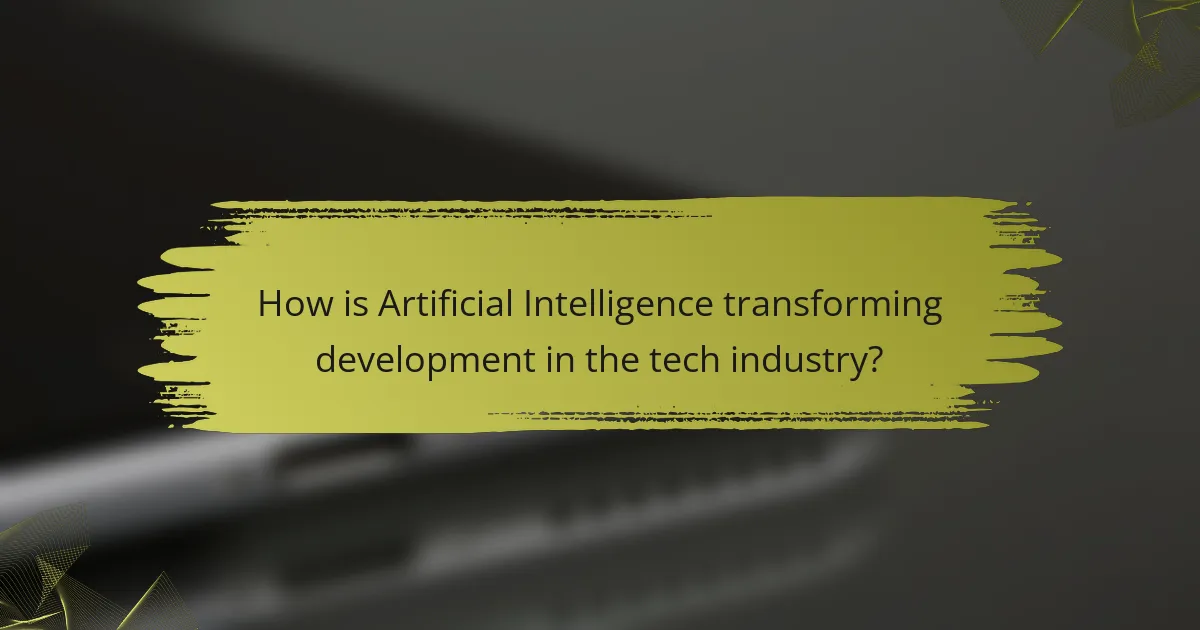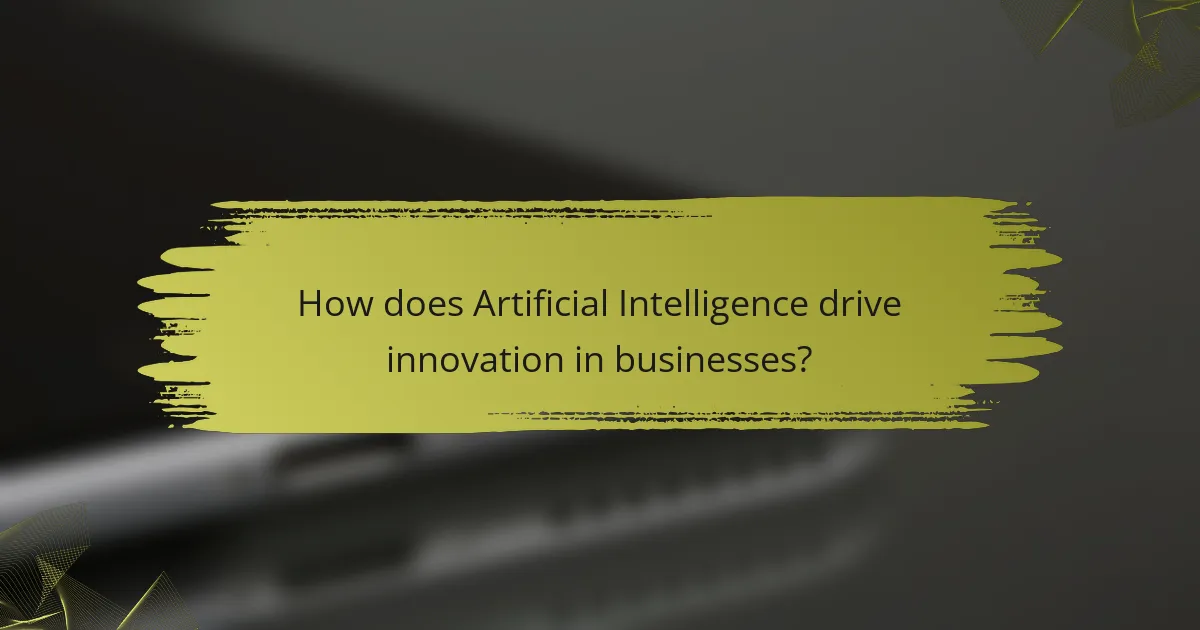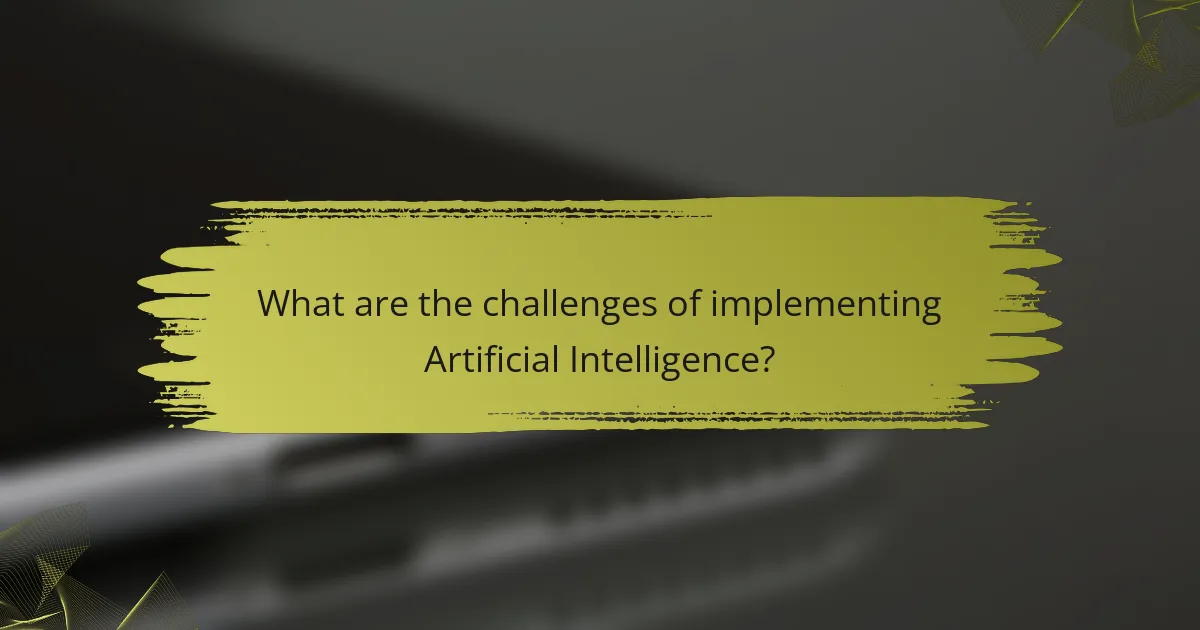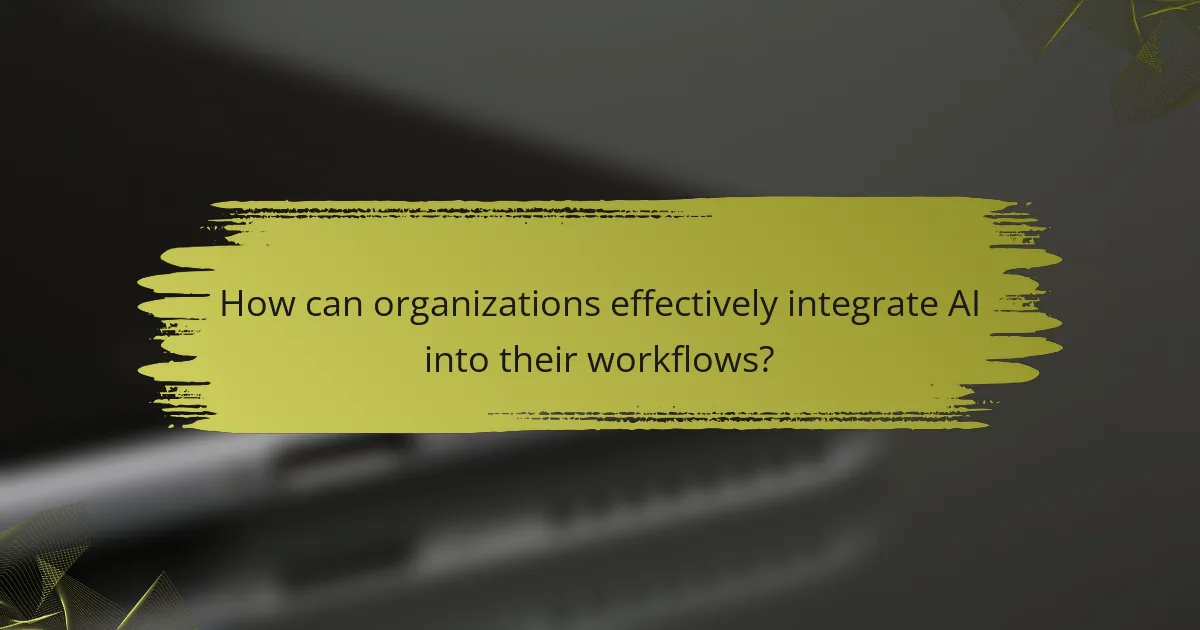Artificial Intelligence (AI) is revolutionizing the tech industry by streamlining development processes, enhancing collaboration, and driving innovation. By automating tasks and analyzing data, AI enables companies to improve efficiency and decision-making, ultimately leading to the creation of new products and services. As teams leverage AI to boost productivity and communication, the potential for groundbreaking advancements continues to grow.

How is Artificial Intelligence transforming development in the tech industry?
Artificial Intelligence (AI) is significantly reshaping development in the tech industry by streamlining processes, enhancing decision-making, and fostering innovation. Companies are leveraging AI to automate tasks, analyze vast amounts of data, and improve software quality, leading to faster and more efficient development cycles.
Increased efficiency through automation
AI-driven automation is revolutionizing how tech companies operate by reducing manual tasks and increasing productivity. By implementing AI tools, organizations can automate repetitive processes such as code generation, deployment, and maintenance, allowing developers to focus on more complex problems.
For example, AI-powered platforms can manage server configurations or deploy applications in a fraction of the time it would take a human. This shift not only speeds up development but also minimizes human error, leading to more reliable outcomes.
Enhanced data analysis capabilities
AI enhances data analysis by processing and interpreting large datasets faster than traditional methods. Machine learning algorithms can identify patterns and trends that may not be immediately apparent to human analysts, providing valuable insights for decision-making.
Tech companies can utilize AI to analyze user behavior, market trends, and product performance, enabling them to make data-driven decisions. This capability is particularly beneficial in sectors like e-commerce and finance, where timely insights can lead to competitive advantages.
Improved software testing processes
AI is transforming software testing by automating test case generation and execution, which significantly reduces the time required for quality assurance. AI tools can simulate user interactions and identify bugs more effectively than manual testing methods.
By integrating AI into testing workflows, companies can achieve higher test coverage and faster release cycles. This approach allows for continuous integration and delivery, ensuring that software is consistently updated and meets quality standards without extensive delays.

What are the collaborative benefits of Artificial Intelligence?
Artificial Intelligence (AI) enhances collaboration by streamlining communication, improving project management, and boosting team productivity. These benefits enable teams to work more efficiently and effectively, ultimately driving innovation and development.
Real-time communication tools
AI-powered communication tools facilitate instant messaging, video conferencing, and collaborative document editing. These tools often include features like automated transcription and language translation, making it easier for teams across different regions to collaborate seamlessly.
For example, platforms like Slack and Microsoft Teams integrate AI to prioritize messages and suggest responses, helping teams stay focused and engaged. Utilizing these tools can reduce response times and enhance overall team cohesion.
AI-driven project management software
AI-driven project management software helps teams plan, execute, and monitor projects more effectively. By analyzing data from past projects, these tools can provide insights into timelines, resource allocation, and potential risks, allowing teams to make informed decisions.
Examples include Asana and Trello, which use AI to automate task assignments and track progress. Implementing these systems can lead to improved project outcomes and better alignment among team members.
Enhanced team productivity with AI assistants
AI assistants can significantly boost team productivity by automating routine tasks such as scheduling meetings, managing emails, and generating reports. This allows team members to focus on higher-value activities that require human creativity and critical thinking.
Tools like Google Assistant and Microsoft Cortana can help streamline workflows by integrating with calendars and task lists. To maximize productivity, teams should identify repetitive tasks that can be automated and leverage AI assistants accordingly.

How does Artificial Intelligence drive innovation in businesses?
Artificial Intelligence (AI) drives innovation in businesses by automating processes, enhancing creativity, and enabling data analysis at unprecedented speeds. This leads to the development of new products and services, improved operational efficiency, and informed decision-making.
Creation of new AI-powered products
AI enables businesses to create innovative products that were previously unimaginable. For instance, companies are developing smart home devices that learn user preferences and adapt accordingly, enhancing user experience. The integration of AI in sectors like healthcare has led to diagnostic tools that analyze medical data to assist in patient care.
To successfully launch AI-powered products, businesses should focus on understanding customer needs and ensuring data privacy compliance. Engaging in iterative testing and gathering user feedback can significantly improve product development.
Improvement of existing services with AI
Businesses can enhance their existing services by integrating AI technologies that streamline operations and personalize customer interactions. For example, chatbots can provide 24/7 customer support, reducing response times and improving satisfaction. Additionally, AI algorithms can analyze customer data to tailor marketing strategies more effectively.
When upgrading services with AI, companies should consider the potential for increased operational costs and the need for employee training. Balancing automation with human touch is crucial to maintain customer trust and satisfaction.
Data-driven decision-making
AI facilitates data-driven decision-making by analyzing vast amounts of data quickly and accurately. Businesses can leverage AI to identify trends, forecast demand, and optimize inventory management, leading to more informed strategic choices. For instance, retailers can use AI to analyze purchasing patterns and adjust stock levels accordingly.
To maximize the benefits of data-driven insights, organizations should invest in robust data management systems and ensure data quality. Regularly updating algorithms and incorporating diverse data sources can enhance the accuracy of AI-driven predictions.

What are the challenges of implementing Artificial Intelligence?
Implementing Artificial Intelligence (AI) presents several challenges that organizations must navigate to achieve successful integration. Key obstacles include high initial investment costs and concerns regarding data privacy and security.
High initial investment costs
The implementation of AI technologies often requires significant upfront financial investment. This includes costs for hardware, software, and skilled personnel, which can amount to tens of thousands to millions of dollars depending on the project’s scope.
Organizations should conduct a thorough cost-benefit analysis before proceeding. It’s essential to evaluate potential ROI by considering how AI can enhance efficiency, reduce operational costs, or drive revenue growth in the long term.
Data privacy and security concerns
Data privacy and security are critical challenges when implementing AI systems. Organizations must ensure that the data used for training AI models complies with regulations such as GDPR in Europe or CCPA in California, which impose strict guidelines on data handling.
To mitigate risks, companies should adopt robust data governance practices, including encryption, access controls, and regular audits. Engaging with legal experts can help navigate the complex landscape of data protection laws and ensure compliance.

How can organizations effectively integrate AI into their workflows?
Organizations can effectively integrate AI into their workflows by systematically evaluating their current processes, selecting appropriate AI tools, and ensuring staff are trained on these technologies. This structured approach helps in maximizing the benefits of AI while minimizing disruptions.
Step 1: Assess current processes
The first step in integrating AI is to thoroughly assess existing workflows. Identify repetitive tasks, bottlenecks, and areas where efficiency can be improved. This evaluation will highlight where AI can provide the most value.
Consider mapping out processes visually to understand the flow of work. This can help pinpoint specific tasks that are time-consuming or prone to errors, making them prime candidates for AI intervention.
Step 2: Identify AI tools suitable for needs
Once current processes are assessed, the next step is to identify AI tools that align with organizational needs. Research various AI solutions, such as machine learning platforms, natural language processing tools, or automation software, that can address the identified challenges.
It’s crucial to consider factors like scalability, ease of integration, and cost. For instance, subscription-based models might be more feasible for smaller organizations, while larger firms may benefit from custom-built solutions. Always evaluate user reviews and case studies to gauge effectiveness.
Step 3: Train staff on AI technologies
Training staff on the selected AI technologies is essential for successful integration. Develop a comprehensive training program that covers both the technical aspects of the tools and the strategic implications of AI in their roles.
Encourage a culture of continuous learning by offering workshops, online courses, or hands-on training sessions. Ensure that employees understand not only how to use the tools but also how to interpret the results and make data-driven decisions.

What are the ethical considerations of Artificial Intelligence?
Ethical considerations in artificial intelligence (AI) focus on the implications of its use, including fairness, accountability, and transparency. Key issues include bias in algorithms and the potential for job displacement, which can significantly impact society and the economy.
Bias in AI algorithms
Bias in AI algorithms occurs when the data used to train these systems reflects existing prejudices or inequalities. This can lead to unfair outcomes, such as discrimination in hiring practices or biased law enforcement decisions.
To mitigate bias, organizations should ensure diverse and representative datasets, regularly audit algorithms for fairness, and implement transparency measures. For instance, using a balanced dataset that includes various demographics can help create more equitable AI systems.
Job displacement concerns
Job displacement due to AI refers to the potential loss of jobs as automation and intelligent systems take over tasks traditionally performed by humans. This concern is particularly relevant in sectors like manufacturing, customer service, and transportation.
To address job displacement, stakeholders should focus on reskilling and upskilling workers to prepare them for new roles created by AI advancements. Governments and businesses can collaborate to provide training programs that equip individuals with the skills needed in an evolving job market.



